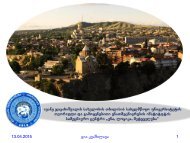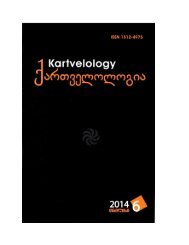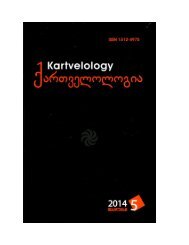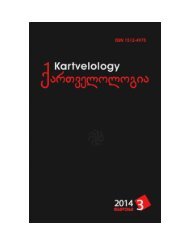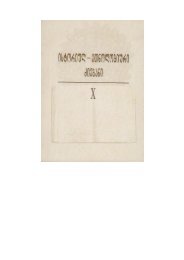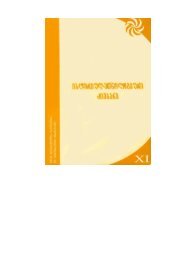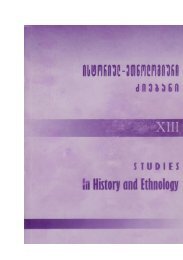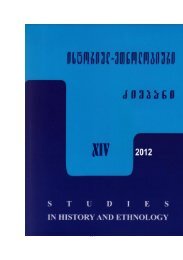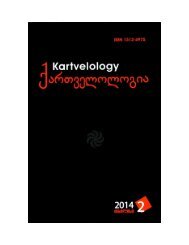Kvashilava, Gia, 2010. On Reading Pictorial Signs of the Phaistos Disk and Related Scripts (2). Rosette (in Georgian and English)
This study concerns the graphic character, symbolic meanings, typological parallels, commentaries and reading of the Phaistos Disk pictorial sign PHD38.
This study concerns the graphic character, symbolic meanings, typological parallels, commentaries and reading of the Phaistos Disk pictorial sign PHD38.
Create successful ePaper yourself
Turn your PDF publications into a flip-book with our unique Google optimized e-Paper software.
(Me<strong>in</strong>ekius 1849, 36, 16-18; Holstenius, Berkelius 1885, 24, 29-31):<br />
”Aea: <strong>the</strong> town <strong>of</strong> Colchis, founded by Aeëtes, is 300 stadia<br />
away from <strong>the</strong> [Black] Sea; two rivers are flow<strong>in</strong>g round it<br />
Hippus [Tskhenis-tsqali – river-horse] <strong>and</strong> Kyáneos [Tekhuri ?],<br />
that turn <strong>the</strong> [town] <strong>in</strong>to a pen<strong>in</strong>sula…” (also see: Kaukhchishvili<br />
1936, III, 274; Urushadze 1948, 218 29 <strong>and</strong> ff.; 1964, 230;<br />
Lordkipanidze 2000, 15, Fig. 1).<br />
Below <strong>the</strong> read<strong>in</strong>gs <strong>of</strong> some <strong>in</strong>scriptions found on <strong>the</strong> Crete,<br />
also <strong>of</strong> Assyrian <strong>and</strong> Urartian <strong>in</strong>scriptions are presented.<br />
The signs <strong>of</strong> l<strong>in</strong>e a7 <strong>of</strong> L<strong>in</strong>ear A <strong>in</strong>scription on HT 117 (HM<br />
1364) tablet – [KU-KU-DA-RA] 1 (GORILA 1976, I, 196-<br />
197) were connected by D. W. Packard (1974, 146) to Myceneaen<br />
Greek: [ko-ki-da] KN Sd 4403.a (L 128); KN So (1) 4430.a<br />
(L 130) <strong>and</strong> [ko-ki-de-jo] KN Fh 5465 (141) (Evans 1952,<br />
II, pl. XIV, 04.03; CoMIK 1990, II, 204, 216; DMic 2 ), that were<br />
correspond<strong>in</strong>gly read by O. L<strong>and</strong>au (1958, 72), S. Hiller (1991,<br />
214, 214 53 ) <strong>and</strong> o<strong>the</strong>rs as , – Colchis,<br />
Colchian (comp.: Gordeziani 1999, 100; 2007, III, 470; Gordeziani<br />
2009, 76, 76 7 , 77).<br />
Accord<strong>in</strong>g to <strong>the</strong> latest researches, T. Gamkrelidze (1999;<br />
2002, 45-46; 2004): ”The existance <strong>of</strong> Colchian state is assumed<br />
to exist around <strong>the</strong> 15 th century BC, for <strong>in</strong> <strong>the</strong> Greek<br />
<strong>in</strong>scriptions <strong>of</strong> Myceneaen epoch (<strong>the</strong> 15 th -14 th centuries BC)<br />
many names that were known to us from <strong>the</strong> myth <strong>of</strong><br />
Argonauts – such as: <strong>the</strong> country Aea, Colchis, Jason<br />
(Myceneaen Greek [i-wa-so] KN Xd 7756; PY An 519.8,<br />
654.17, 661.3 (S657-H 1); PY Cn 655.6 (S719-H 1); Greek<br />
, ), etc are attested”.<br />
1 . Comp. <strong>the</strong> Myceneaen Greek mascul<strong>in</strong>e anthroponym [ku-ka-daro]<br />
KN Uf (2) 836.b (122) (DMic 2 ; Younger 2008-2010).<br />
320




